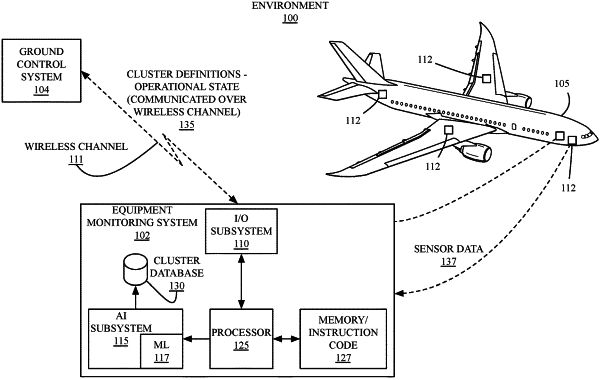| CPC B64D 45/00 (2013.01) [G06N 20/00 (2019.01); B64D 2045/0085 (2013.01)] | 20 Claims |

|
1. A method implemented by a computing system, the method comprising:
receiving, by an equipment monitoring system (EMS) of an aircraft, first training data from a plurality of sensors of the aircraft over a first operating interval of the aircraft during a first flight, and second training data from the plurality of sensors of the aircraft over a second operating interval of the aircraft during a second flight;
appending, by the EMS, first buffer data between the first training data and the second training data to provide extended training data;
determining, by the EMS, whether the extended training data reaches a threshold extent of data;
appending, by the EMS, second buffer data to the extended training data when the extended training data is less than the threshold extent of data and repeat training data collection from the plurality of sensors of the aircraft over a third operating interval;
based on determining that the extended training data reaches the threshold extent of data, clustering, by the EMS executing a multivariate window-based clustering algorithm to train the multivariate window-based clustering algorithm for the aircraft with training data that spans multiple flights of the aircraft, the extended training data into a plurality of data clusters associated with a plurality of operational states of the aircraft, such that values of sensor data from the plurality of sensors in the first training data and the second training data received during each operating interval are clustered according to being associated with a same operational state of the aircraft, wherein the plurality of operational states include valid operational states and invalid operational states and specifying values of the first buffer data so that the first buffer data clusters into an invalid operational state;
subsequent to clustering, receiving, by the EMS, operational data output from the plurality of sensors of the aircraft over a fourth operating interval;
determining, by the EMS executing the trained multivariate window-based clustering algorithm, a particular data cluster of the plurality of data clusters to which the operational data output from the plurality of sensors belongs; and
communicating, by the EMS of the aircraft via a wireless channel, data indicative of valid operational states of the aircraft associated with the particular data cluster to a control system.
|